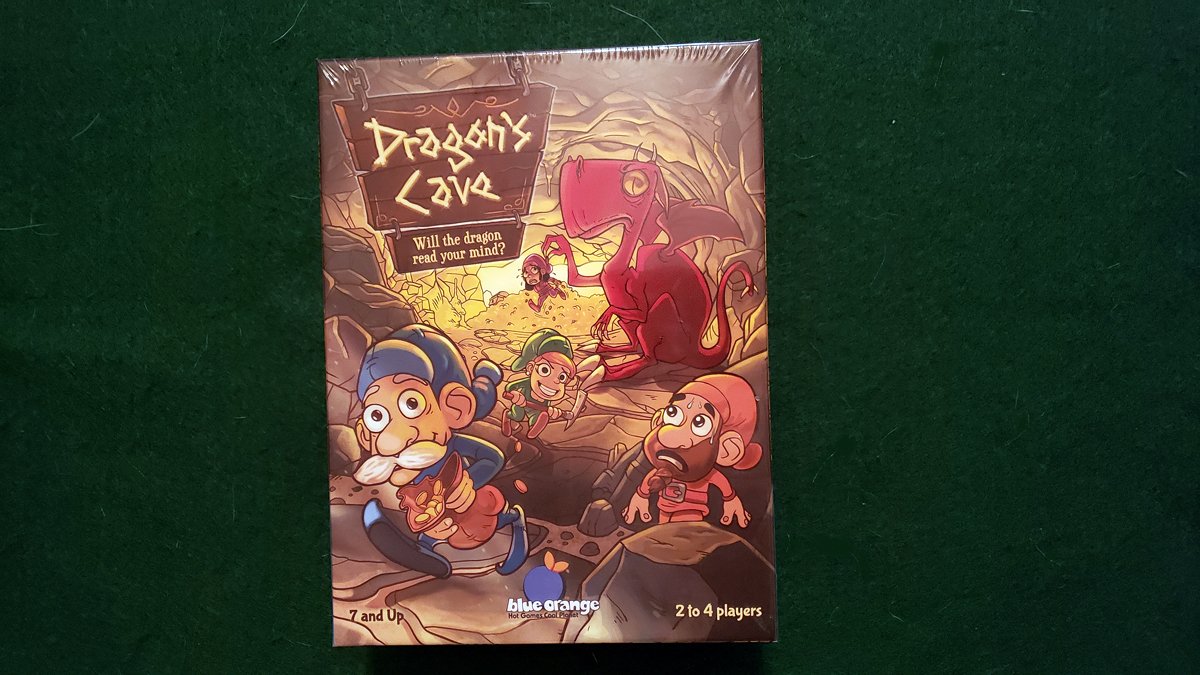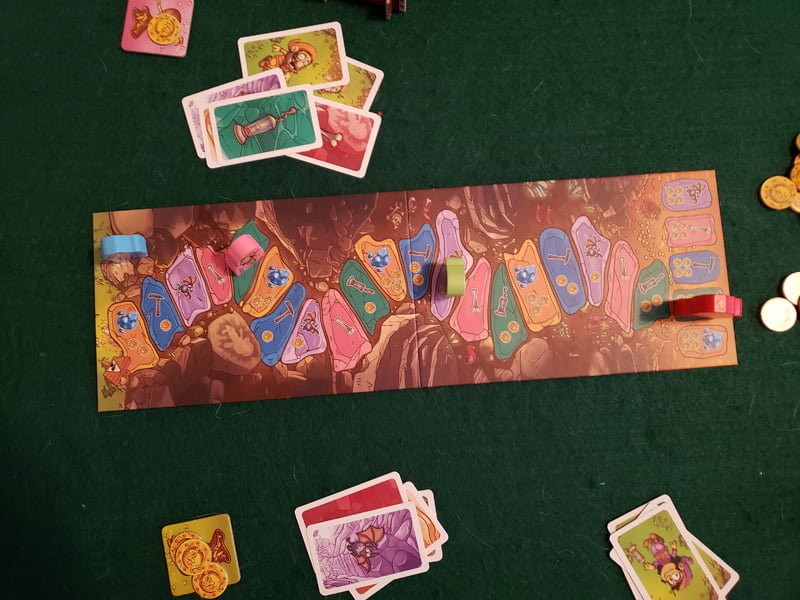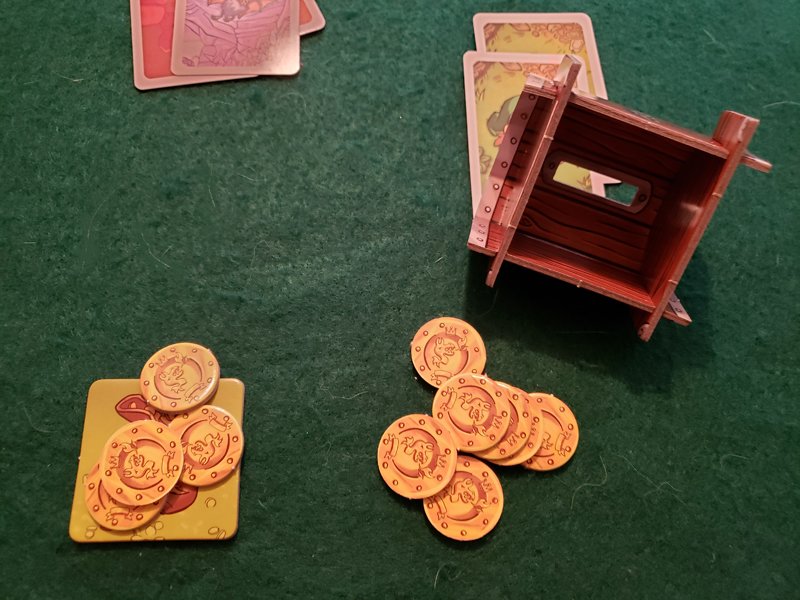
In this past year, my kids have really enjoyed the Blue Orange Games that we’ve had a chance to review, including some of the newer 2019 offerings like Sprint!, Oh My Gold!, and Tumble Maze. So when an opportunity for reviewing a copy of Dragon’s Cave came up, I was quick to jump at the opportunity.
What Is Dragon’s Cave?
Dragon’s Cave is a bluffing type family game for 2 to 4 players ages 7+ and takes about 25 minutes to play. It has an MSRP of $15.99.
Dragon’s Cave Components

Dragon’s Cave contains the following:
- 1 Board
- 1 Dragon
- 4 Dwarves
- 44 Gold Coins
- 4 Treasure Chests
- 4 Purses
- 24 Cards (4 sets of 6 different cards)
Overall, my impression is that the pieces are nicely made, especially for the game’s price range. The board is decently thick, although it does fold, so younger kids might be rough on that if they try to bend it the wrong way. The Dragon and Dwarf figures are actually made of wood, so that’s always nice. The Treasure Chests are a thick cardboard and require minor assembly, but our third-grader was able to do that on his own without damaging the Treasure Chests. Once assembled, they will go back in the box without disassembly, too. The Purses and Coins are a similar thickness to the chests and should be able to handle lots of play. The Cards are about playing card thickness and should hold up to the play that are intended for. The artwork on the pieces is a lot of fun and should appeal to the kids that the game is intended for.
How to Play Dragon’s Cave
Goal
The Goal of Dragon’s Cave is to be the player with the most gold at the end of the game. You accomplish this by trying to steal gold as a Dwarf but also by trying to stop other players as the Dragon.
Setup

My general rule is the younger the age range for a game is, the simpler I like to see setup. I do enjoy playing games with the kids, but I know they will play a game more when they can set it up and play it with other kids without me.
The first time you play, you do need to punch out the cardboard pieces and assemble the Treasure Chests. As I noted before, our third-grader was able to easily assemble the Treasure Chests on his own, so it doesn’t take too much time at all. Once your pieces are ready, do the following:
- Give each player a Dwarf and the color matching Purse. Then each player gets a set of Cards and a Treasure Chest.
- Put the Dwarves on the board outside of the Dragon’s Cave.
- Put the Coins in a pile by the Dragon’s Lair.
You are now ready to play a 3-4 person game. There is some variation in a 2 person game, but for this review, I will focus on a 3-4 person game like we played.
Gameplay
Gameplay catches on pretty quickly. One player will take the role of the Dragon trying to protect the treasure, and the other players will act as Dwarves trying to steal the treasure.
Game Round
- Each player takes turns selecting a Card and placing it down in front of them.
- The Dragon player (youngest player gets this job first) sets the Dragon on one of the colored spots in the lair.
- Players reveal their Cards. If they picked a different Card than the Dragon’s spot, they move to that spot and collect any Coins indicated on the spot.

The players have escaped the Dragon! Photo by Elizabeth MacAndrew. If they picked the Treasure Chest, their current Coins go from the Purse into the Treasure Chest and are protected. If they picked the Card that matches the Dragon’s spot, they were scared by the Dragon. They move back until they find the nearest spot that matches their Card or to the beginning if that spot does not exist.

Caught by the Dragon! The Pink Dwarf moves back. Photo by Elizabeth MacAndrew. Now the Dragon can steal any treasure they have. The unfortunate player divides their Coins between their hands (a hand can be empty) and offers two closed fists to the Dragon player. The Dragon player picks a fist, and any Coins in that fist return to the Lair pile. The player puts any remaining Coins back in their Purse.

The Dragon turned up empty handed. Well played, Dwarf. Photo by Elizabeth MacAndrew. - The Dragon position is passed on to the player to the left of the current Dragon player and game play continues.
Things to Remember
- Cards that have been played remain in front of a player unless the Dragon catches them or they play the Treasure Chest card.
- The Dragon player does not play their cards or Dwarves.
- Coins in the Treasure Chest are safe from the Dragon.
Two-Player Variation
In order to play the game with two players, you follow most of the rules of a game for three or four players. The differences are as follows:
- Each player selects two Dwarves.
- On a turn, one player is the Dragon, the other player plays their Dwarves. The Dwarf player may only pick one Dwarf to move for a round while the other is protected.
- Dwarf and Dragon player do not switch roles until a Dwarf is caught or the Treasure Chest Card is played.
Game End
The game ends at the end of a round where a player has reached the Dragon Lair and landed on a spot in the Lair that the Dragon is not occupying OR if the Coins run out in a round. If the Coins run out without all players being rewarded coins that should receive them, the remaining coins are divided equally among the players who should have received coins and any extras are simply not handed out.
All players will now count the coins in the Treasure Chests and Purses, and the player with the most Coins wins.

Why You Should Play Dragon’s Cave
I will freely admit, I’ve been a big fan of the Blue Orange Games that we’ve played so far, and I find them to be a great family and kid game brand overall. Like the other games we’ve played from the company, Dragon’s Cave is made of solid components, especially for the price range the games fall into. They tend to be enjoyable for parents to play with kids, but are also easy enough to set up that kids will independently play them without grown-ups and can easily teach them to friends.
Dragon’s Cave hits a nice little balance of luck and strategy. While the players are at the whim of the Dragon, the Dragon player certainly has an edge in being able to know what cards the Dwarf players have already played and focus their guesses a little better. This might give the Dwarf players a little extra sense of the nerves, but since they are supposed to be sneaking up on a dragon, that seems to line up with gameplay rather nicely. There’s also that debate of how do you split up the Coins between your hands if you get caught and when do you protect yourself with a Treasure Chest Card. It might be a bit too much strategy for players under the recommended age of 7, but for kids in that age range, it’s enough strategy to encourage critical thinking without making kids overwhelmed by the skill level of older players. The game actually plays pretty fast, and our game went under the expected time enough that it was easy to fit in multiple games. I find that the younger your players, the more they tend to appreciate games in that 15-25 minute range based on age-level attention spans. The game does feel like it has great replayability and is really good practice for kids to take risks in creating strategies.
With an MSRP of $15.99, the game is an easily justified purchase, either for your own kids and family or for other kids as a gift. You can buy it from Blue Orange Games or on Amazon.


